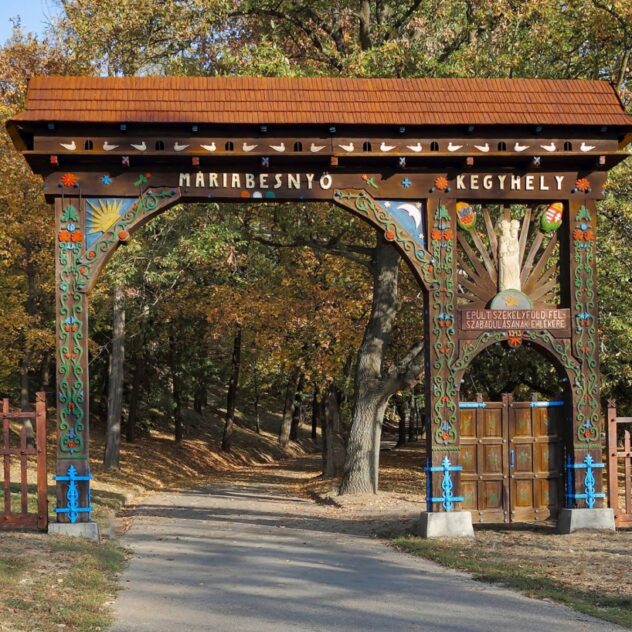Máriabesnyő shrine
Information about the pilgrimage site
Turkish and Tatar invasions left the settlement of Máriabesnyő devastated a lot of times during history. The settlement, the present of King Béla IV, was an estate of the Premonstrant Church in Hatvan (Hungarian small town close to Gödöllő) from 1214 for almost 300 years until the Turkish invasion. The proof for this historical fact is that Antal Grassalkovich I, who became the proprietor of the settlement – a deserted one at the time – in 1737, found the ruins of a Promonstrant church there. Antal Grassalkovich I was a true Catholic. He had a personal license for a travelling altar from the pope at which he took part in a regular church ceremony as he was a prevalent traveller. When his third wife, Therese Klobusiczky got seriously ill, Grassalkovich prayed for her and swore that, in case she got cured, in gratitude for the Holy Virgin, he will have a church built. His wish was fulfilled, his wife got well, but because Grassalkovich was waiting for a sign for the site of the church, the building process was delayed. In 1758 during his travel from Hatvan to Gödöllő, his horses became wild in Máriabesnyő at the ruins of the Premonstrant church and he took this as a heavenly sign. It was rich noblemen’s habit to build a Loreto chapel (one that is the duplicate of the original in Loreto, Italy) and have a Virgin Mary statue (one that is touched by the original one in Loreto) erected in the chapel. The cedar statue for the altar in Máriabesnyő was transported on foot to the site by two Capuchin monks in 1759. János Fidler, a mason from Gödöllő, had a dream about a small bone statuette under the ruins of the church, which he eventually found on 19 April. The statue probably dates back to the 12th century and it portrays the Virgin Mary with the little Jesus in her arms. It is 11cm tall and 4cm wide. The circumstances of the miraculous rediscovery of the statue were certified by Count Kristóf Migazzi, Archbishop of Vác. The ornaments on the crown and belt were made by 23 diamonds of the Grassalkovich family jewellery. The statue in a silver case with a crystal window was then placed in the castle church in Gödöllő and the duplicate statue from Loreto with a silver crown was placed in Máriabesnyő chapel that was consecrated in 15 August 1761. Following the miraculous happenings in Máriabesnyő – the crippled hand of a butcher from Gödöllő got cured – and the adherent pilgrimage torrents to Máriabesnyő, Grassalkovich decided to enlarge the church to welcome the pilgrims. Because the church was built on a hill, the architect, András Mayerhoffer decided for a special multilevel architectural solution. First he built the crypt of the Grassalkovich family and the lower church, and then the Loreto chapel, the upper church, which currently functions as a sanctuary. The church was consecrated on 17 March 1771. Inside there is the altar facing the auditorium.
The two storey baroque church with the two altars and the Virgin Mary Statues is a unique site in Hungary that attracts thousands of pilgrims every year. The high altar, erected in 1917, is where Hungary’s smallest, 11cm high and 4cm wide, miraculously found bone statue is placed. The altar behind is home to the Loreto Statue brought by two Capuchin monks on foot to Máriabesnyő. The church was built in 10 years (1761-71). It is one of the most frequented Marian pilgrimage sites among the 33 churches built or reconstructed by Antal Grassalkovich I and his wife. The lower church is home to one of the most beautiful baroque shrines in Hungary. The enormous marble sarcophagus in which Natal Grassalkovich I and his wife lies is the work of art of Georg Dorfmeister.
The side altars are decorated with paintings by Norbert Baumgartner, Capuchin monk from Vienna (dating back to around 1770) and the inside walls are the frescoes and windows of Lajos Márton. The golden confessionals date back to the 18th century. The side altars are also decorated by Norbert Baumgartner’s works, the frescoes and windows by Lajos Márton.
Written documents mentioning the settlement as Máriabesnyő date back to the 19th century. The church was renovated and the two churches (upper and lower) were merged. In 1963 the church was declared an independent parish. The church ordained in honor of the Holy Virgin was voted and proclaimed a basilica minor by Pope Benedict XVI on 15 August 2008
Tourist attractions in the vicinity
Gödöllő Royal Palace – One of Hungary’s largest Baroque monuments, initially named after the Grassalkovich family, gained widespread recognition as the royal residence of Empress Elisabeth (Sisi) and Emperor Franz Joseph I. It offers permanent exhibitions, as well as the opportunity to visit the stables, Baroque theater, and palace park.
Turai Botaniq Castle – Considered one of Hungary’s most beautiful castle hotels, it features Neo-Renaissance and Neo-Baroque architectural elements. Built by Zsigmond Schossberger for his wife, the castle now operates as a luxury hotel with 19 rooms, providing a five-star experience. It is surrounded by a fairytale-like 10-hectare park, open to visitors by prior appointment.
Veresegyház Bear Sanctuary – Spread over 11 hectares, it is home to dozens of bears and 29 wolves, serving as the only Bear Sanctuary in Central Europe. Visitors can participate in feeding the bears with fruits and vegetables, and enjoy a unique forest mine train ride operated by the Museum Railway, featuring historic mining locomotives. The train travels through the forest on a circular track of approximately 1500 meters, passing through a mining cut as well.
Mogyoród Aquaréna – Hungary’s most attractive water park offers opportunities for active relaxation for all ages. Apart from the 26 slides totaling one and a half kilometers in length, one of the main attractions is a 300-meter-long Slow River winding around an island, forming a spring cave.
Hungaroring – Hungary’s most significant motor racing circuit, primarily known for hosting the Formula One Hungarian Grand Prix since 1986. In addition to Formula One, it hosts events like the FIA World Touring Car Championship, TCR Europe Trophy, FIM Speed Motorcycle World Championship, DTM, and Superbike World Championship.
Other tourists attractions in the vicinity of the Máriagyud pilgrimage site can be found on the website of Local tourism Authority Gödöllő http://web.godollo.hu/tourism/greeting/index.php
Accommodation
- Accommodation for pilgrims is possible at the Mater Salvatoris Retreat House (https://mariaut.hu/tart-accservice-63/Mater_Salvatoris_Lelkigyakorlatos_Haz_es_Konferencia_Kozpont).
- Other private accommodation in the vicinity of the pilgrimage site.
Availability
By car
Máriabesnyő shrine is eassily accessible by car. It is only 35 km from Budapest via M3 Moterway.
By public transport
Máriabesnyő is administratively part of Gödöllő, yet it has its own railway station on the Budapest Keleti-Hatvan railway line. . By road, it is accessible from Budapest via the M3 motorway and the triple main road. Additionally, it can be reached by bus with a transfer in Gödöllő from Budapest, but the bus stop is directly at the church.
On foot
For pilgrims, it is accessible via the Maria Way, which is a nearly 200 km section enclosed by the pilgrimage triangle of Máriabesnyő-Gyöngyös-Mátraverebély-Szentkút.
On a bicycle
Cycling routes are well marked on tourist maps.








